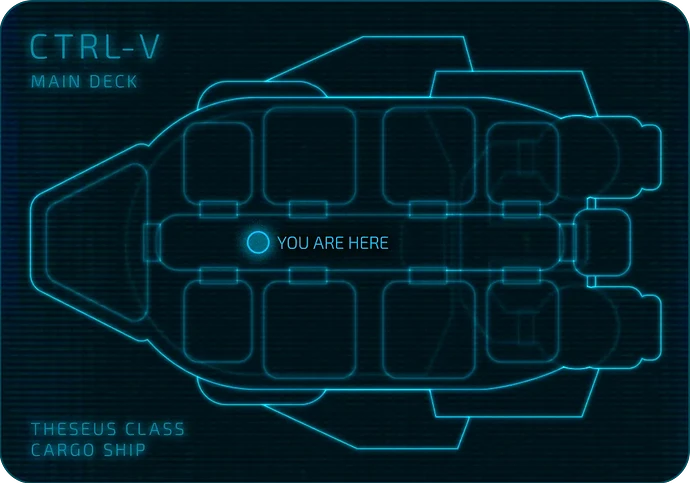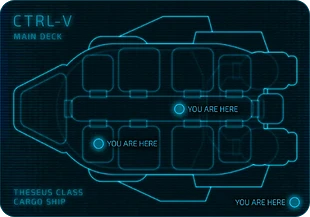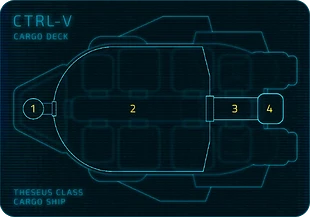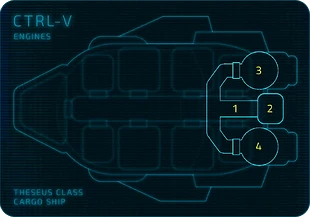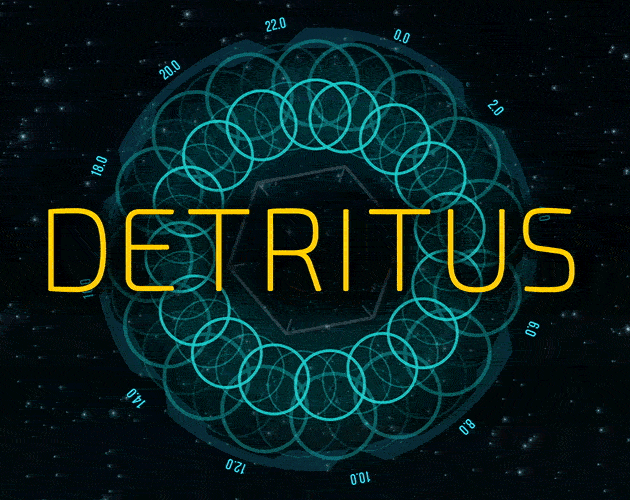This is an overlong, rambling post-mortem, and like many authors, I could bang on for ages about boring minutiae. But this year, I figured I’ve earned the right to ramble a bit – and seriously, you don’t need to actually read any of it. Also, there will be major unhidden spoilers, so if you’re ever planning to play the game, it’s probably better to do that first. Feel free to skip read!
detritus (/dəˈtraɪtəs/ or /ˈdɛtrɪtəs/) The small pieces of rubbish that remain after an event has finished or when something has been used. Also used to describe organic matter made up of the decomposing remains of organisms and plants (and also of feces).
Yep, that’s what this game is about. Y’all voted for game about crap to win the comp.
I went through several options on the name. It was called ‘CTRL-V’ at first (as in CTRL-C / CTRL-V - the keyboard command for Copy/Paste). I very nearly went with ‘Human Resources’ which works pretty well, but in the end, I stuck with ‘Detritus’ – and the meaning of the title shifts as the player progresses through the story.
ORIGINS: THE PARSER / CHOICE CONUNDRUM
The first ideas for this game actually started fairly recently, after experimenting with different game mechanics (and including experimenting with audio and video effects) in my previous game (‘Echoes’ - Spring Thing ‘25).
I was thinking about the inherent benefits of parser vs choice. I find parser games to be much less approachable if you’re not already immersed in the ‘rules’ - interacting with a parser game is a puzzle in its own right – especially for those new to IF (always something I think about). But even the simplest parser games often have a more complex world with more ways to interact with stuff. So I started playing around with simplifying some of those advantages into something that could work in a choice game.
I was originally thinking along the lines of something like the ‘SCUMM’ point/click (ie. a drop-down set of verbs that you can choose to apply to a set of items and locations). But I soon stumbled into a big brick wall with this: I’m not a coder, so pushing the boundaries of what’s possible in Twine isn’t something I’m capable of, and my inner sanity check could actually hear the final reviews all saying: ‘Hey, this is alright, but it would have been better as a parser game’ (and I’ve had that comment made several times about stuff I’ve previously made!)
So, I moved to a different idea (this was around the end of June). At this point, it was largely just a coding/UI challenge to create a robust object/inventory system that could handle loads of objects (in multiple locations) that the user could interact with in different ways. Not really aping parser games, but definitely more complex than the average Twine game, and opening up a much wider range of possibilities for the player. I tried using ‘off-the-shelf’ inventory plugins, but the problem with those is that if I don’t understand how they work, I can’t modify them to do what I want them to do.
Side-ramble: ‘MVP’. The way I sometimes work is to create an ‘MVP’ (minimum viable product) - a short, ‘vertical slice’ of the game that can demonstrate how it works and gives me an idea of whether it’s then worth pursuing further. In this case, this was what became the first 15 minutes of Detritus (that basically functions as a tutorial).
ITEMS & ‘OBJECTS’
Things I knew at this early stage: it was going to be a Sci-Fi game, story-based, but also with some mechanics that made for a more complex gameplay experience. I wanted to make a AAA game in text form – well, it’s important to have an unachievable goal to aim for ![]() .
.
With some coding help from Aster (thanks @pieartsy!), I got an initial system working (around early July). It involved learning all about arrays and ‘objects’ - which I’ve never come across before and made my head hurt for weeks. I do try to learn something new with each game I make, and this was definitely a big learning experience!
Then started looking for a way to make use of it, a core mechanic and a story that revolved around it. My immediate thought was the idea of ‘recycling’ and then ‘fabricating’ new stuff - inspired by the video game ‘Prey’ and also a more obscure VR game called ‘The Persistence’ – a roguelike where if you died, you got reprinted (and later on, you could find and scan other crew members and get reprinted in their body instead). You could also use the printing system to create a variety of items and weapons to help you out.
So the goal was to create a survival/roguelike ‘videogame in text form’ that would make use of these recycling mechanics. Rather than try to ape the freedom of a parser game, I would simply introduce ‘too many’ objects that the player can interact with to give the game a more unique feel. It’s not a classic puzzle game, but it would allow for limited trial/error/experimentation with objects to progress.
Side-ramble: I later dropped the idea of the roguelike. If a player knows they’ll just keep getting reprinted, there’s no peril in death. And too frequent use takes away a bit from the inherent awfulness of being reprinted.
THE SHIP OF THESEUS
I like to write the story (and much of the game structure) as I go (directly in Twine – I know!). It’s a messy way of working that involves a lot of rewrites and revisions further down the line, but it also means you have a lot more flexibility to let the story and game go where it ‘wants’ to. At this early stage, I knew that whilst this wouldn’t necessarily be a big ‘plot twist’ story, it would be moving towards a ‘memorable moment’ based on the recycle/fabricate mechanics the player has been using (the idea of self-recycling was there right from the start).
I have a habit of shoe-horning too many sub-text ideas and references into my stories, to the point where they start to fight and work against each other! This time, I was going to be much more focused (spoiler: I totally failed) and base the entire story on a single idea – the ‘Ship of Theseus’. The original tone was quite light, with an upbeat, mildly sarcastic protagonist. Rather than the standard 2nd person pc, I was going to try first person / present tense, so whilst it’s all happening ‘now’, the protagonist could have their own thoughts, feelings (and crucially ‘memories’) – separate from the player.
The plot involved searching the ship and gradually realising that ‘something mysterious’ was held in the hold (but I wasn’t entirely sure what as yet). And there was going to be a moment of discovery where the player (but not necessarily the player character) discovers they’re not who (or what) they think they are (the ship may be ‘Theseus class’, but it’s the player who’s really the ‘Ship of Theseus’).
Anyway, the MVP worked pretty well (it’s actually amazing how similar the first 15mins remained all the way through production – despite later significant plot and theme changes) and I figured I maybe had just enough time to build it out into an interesting 30-40 min game in time for the IFcomp submission deadline (which was looming fast).
UX / UI
A key part of the collect, recycle, fabricate mechanic was presenting this in a way that it all seemed easy to use, not too limiting, playable across devices (including mobile) and yet, still doable within my limited Twine capabilities. There’s a lot of info for the player to take in, and even more ‘behind the scenes’ stuff, but I did my best to only show the info the player needs at the time. Different options were tried (it was originally all going to use drop-down lists - as they take up less screen space), but in the end, the simplified, clickable list of items seemed to do the job.
I originally thought that learning how to use the various systems would be an enjoyable part of the ‘puzzle’, and I’m sure that would be true for many players. However, I discovered very late on that people were still missing stuff, like how to drop things, why they couldn’t pick up more stuff etc. So I added more ‘nudges’ in the tutorial as a guide. These nudges appear once, only when relevant, and can be skipped, so it’s not annoying for those who’ve already figured it all out.
I even asked one player if they appreciated the ‘fast travel’ map. Turns out they’d completed the whole game and didn’t even know there was a fast-travel option! The game is now full of little, dynamic, context-aware ‘nudges’ to gently point stuff like this out.
Ugh.
Then… well… then I was made redundant from my job and things got a little messier. I was thrust into the (un)employment market, which turned out to be in an even worse state than I initially thought. And it made it all much clearer what a devastating effect gen-AI (and even just the ‘idea’ of gen-AI) is having on the creative industries. Which is strange, because it didn’t seem that way while in a full-time job. I even saw job ads looking for skilled designers to spend their days training some AI system so… it could take their jobs. And that did start to make me angry.
So in between doom-scrolling on LinkedIn looking for jobs to apply for, I suddenly found myself with a lot more spare time than I’d imagined. And this is the project that absorbed me, it kept me busy, it kept me sane (and also drove me a little bit mad!). The tone of the story gradually gets darker as you progress. I liked that this reflects the PC’s changing mood and understanding of their own situation, but it also reflected mine.
AAaaiiiiiii (AKA the Wilhelm Scream)
If you’re triggered by the endless and annoyingly gen-AI debates, don’t read this bit
I’ve developed a complex (some might say ‘confused’, some might say ‘wrong’) viewpoint on the whole AI debate. I have no issue with anyone who wants to experiment with these new, undeniably impressive tools. It’s fun to experiment and we shouldn’t punish people for trying. I still think the considered, sparing and curated use of AI tools can potentially aid creative projects. In fact, I’m not sure if you can talk with authority on the subject unless you’ve at least tried to put them to use.
The real issue I have is with the huge companies hoovering up human creativity to make these things in the first place, and the industries now using these tools to essentially replace their human workforce with an almost inevitably inferior end result – whilst telling us all they’re improving the experience. It’s amazing how much hype there is of AI, and how few genuine examples there are of them making life better. It’s not the AI’s fault. It’s not the individual’s fault. Look at Open-AI, Anthropic, Microsoft, or Google if you’re looking for someone to point a finger at.
Some of this anger seeped into the story. It started as mildly sarcastic object descriptions, expanded into on-the-nose mascot lines, but ended up becoming a much bigger part of the overall (albeit underlying) theme. But it was important that it never dominated the ‘Sci-Fi adventure’. Fairly early on, there’s talk of the crew being ‘replaced’ by the AI, of unions giving up, and contracts being changed. It sets the AI up as the ‘bad guy’, but when you first encounter ‘GAIL’, she’s just a bit ‘flaky’ – in fact, she’s almost comically useless. By the end (depending on the ending you chose), you realise that she’s kinda on your side – at least, way more on your side than the big corporation ever was.
Strategic Lateral Offset Procedure
Ok, so I had an established mechanic based on Recycling, and I wanted to use this to mention some of the real-world recycling / green-washing issues as part of the sub-text. The crew of the spaceship were originally going to be zero-hour contractors employed for a Sci-Fi equivalent of an Uber/Amazon -ish delivery firm. But I knew that by adding all this other stuff in, I was in danger of diluting the core idea, so I kept much of that as implied rather than fleshed out.
Then, as the final ‘layer’, I wanted to add in stuff about AI taking jobs and the danger of ‘AI slop’ slowly drowning human creativity. But I needed some way to connect these ideas without it ever dominating the core game and feeling obvious or out of place. In fact, the goal for me is always to create a game that entertains first, and if it perhaps raises a few questions too, all the better.
The final inspiration came from a news story on July 18th:
https://www.independent.co.uk/bulletin/news/microsoft-human-waste-carbon-footprint-b2791325.html
Well, of course! The cargo hold isn’t carrying something horrible/mysterious at all. It’s shipping the literal embodiment of AI ‘slop’. It’s shipping it halfway across the galaxy, not because that makes sense, but because companies (and planets) are just shifting this waste around for profit and to balance the books (the idea of ‘offsetting’ is quite strange when you look at things from a global perspective).
Anyway, this is the final ‘layer’ of the story. I thought this line, found towards the end, would be the big give-away: “Huge floating lumps of – I can only describe it as ‘slop’” – but I guess it got buried a bit. And of course, whilst the game raises questions, it doesn’t pretend there are any easy answers. The final player choices that lead to the three main endings basically equate to: How do you feel about gen-AI?
a: it angers me, I want to burn it all to the ground
b: it depresses me, I want to have nothing to do with any of it
c: we’re going to have to work with it, whilst holding on to what makes us human
c. is actually the most optimistic of the endings, and also seems to be the one most people picked.
Side-ramble: I got some very late feedback from someone I’ll refer to as ‘the Captain’, who pointed out that all the endings were a bit depressing and basically let the ‘company’ off the hook. Whilst you can see why, based on the above, on reflection, I think the Captain has a point, so the post-comp version rewards players who have collected enough ‘evidence’ with a slightly more optimistic ending variation.
A PUZZLE GAME?
I’m still not sure if this is a puzzle game. I mean, the mechanics themselves need some figuring out, as does the resource management. Sure, you need certain items to get into certain rooms, but is that a ‘puzzle’? A longer game needs some variety to keep players interested.
In last year’s entry, I turned Wordle into a hacking mini-game. I wanted something similar, but something that didn’t dominate the game itself – it was just a way to utilise a different part of your brain to unlock the next thing. I’d already created the keypad using some basic CSS (I was quite proud of that – until someone informed me that it broke in a specific browser on Linux. I mean c’mon browsers, can’t you just agree on stuff!!? I fixed it later – I think). So I used a similar approach and knocked up the keypad hacking, with an idea of doing a very simple 3x3 ‘Soduko’ type thing. And it was fun to use, but really annoying to solve. Then I added the ‘Circuit tester’ (a side panel that tells you what the rows and columns should add up to) and that was more fun. I briefly considered using it on more doors, but I recognise that people’s patience would wear thin after doing it a couple of times.
There’s also the use of ‘bodies’ - this was a tricky balancing act to ensure it was easy enough to figure out what to do if you’d figured out what to do – but didn’t just present you with the solution (an inherent problem with choice games).
For the final sequence, the engine repair, I wanted an actual puzzle that makes use of the main ‘detritus’ mechanics, but is also a reflection about what’s really going on. You have to repair something really complex by using the random junk you find lying around. Once you’ve got it working, the question is: if it works, does it matter what you used or how you made it? And of course, you do this just before discovering how you were made. I think a few people thought it was a bit unrealistic, but I still think it kinda works (although I have now sign-posted that last item just a tiny bit more).
Side-ramble: There’s only one ending variation that mentions the word ‘Frankenstein’ - you only see that if you kill your creator. But there are definitely parallels; it’s just that in this story, it’s told from the monster’s point of view – they just don’t know who or what they are.
STRUCTURE & PLACE
The game is set in a limited space - the ship itself. I often start with the space, create a set of rooms/locations and then figure out what goes in them. The map of the ship was created very early on. The backstory is told through the use of ‘flashbacks’ and datapads. These are essentially player rewards for exploration. Some are missable, and many can be found in a different order, depending on the player’s actions. That made balancing the pace, storytelling and the resource gathering tricky! There are several ‘tricks’ in place that ensure that while the player has freedom to do things in their own order, they will ‘tend’ to stick to a critical path.
The flashbacks are meant to be a little jarring at first; they represent sudden, returning flashes of memory. Initially, they sort of make sense, but when the player gradually realises they’re all from different points of view, they start to get the idea that something isn’t quite right (that’s enough for some people to figure it all out there and then – but that’s ok). There are some simple player choices shown in most of the flashbacks, making them a bit more interactive, but also reinforcing that yes, you’re there, you’re ‘them’. Each memory gives the briefest of glances into the lives of the crew. They’re not enough to flesh out their characters fully, but they’re glimpses of their humanity, their weakness, their emotions, a sense of touch. Almost like little snatches of recordings – interpreted by something that doesn’t entirely understand.
Side-ramble: The ‘paperclip maximiser theory’. If you made and read the description for the ‘paperclip’ in-game, you’d see: 'In the old days, it was made to clip ‘paper’. Now it’s just used as an ornament, or occasionally to discuss the ‘paperclip maximiser’ theory’ This is a theory that if an AI were given a single priority: to maximise the production of paperclips, it would eventually lead to the destruction of humanity. While it’s not entirely serious, it does sound a warning that we should be very aware of what an AI’s ‘priorities’ really are. The entire story hinges on GAIL’s obsession with her given priorities.
AUDIO & FX
For some reason, I decided right at the start I wanted music. I also clearly remember the sound the ‘Recycler’ made in Prey as the raw resources tumbled out, so I wanted some spot effects too.
I stumbled over the main theme on a royalty-free music site. It’s catchy, sci-fi and reminds me a bit of the theme from Subnautica. Despite hearing it over and over, I still like it!
I wanted to have a second track playing within the game itself, but it would have to be much more ‘ambient’ and ‘background’. I couldn’t really find anything that fit perfectly, so I kind of mixed my own. It’s made from around 6 or 7 free audio sources mixed together to create an eerie, sci-fi ambient track (5.30min). Lots of people probably just turned it off. But it sets the slightly creepy, melancholic mood, and also hints at one of the final secrets. If you listen to it, you can clearly hear a very slowed-down version of the ‘My bonnie’ song in the background.
My Bonnie lies over the ocean…
I wanted something ‘human’ that tied the crew together somehow. Something that’s more suggested than defined, like a shared memory. And I liked the idea of having my own version of the classic ‘Daisy…’ song from 2001 (now, forever associated with a creepy AI). It was when writing the bit about recycling the Captain that this tune popped into my head, and I found myself singing the wrong words, ‘My body lies over the ocean’. I just thought that was funny and decided to use it. It struck me later that maybe a worldwide audience isn’t so familiar with this old Scottish song, so I went looking for an actual audio recording I could use. With luck, I managed to find one, recorded in 1909(!) – not very sci-fi! I eventually realised that if GAIL’s training data contained everything humans had ever created, well, this could make sense. This developed into another (minor) sub-plot: why did the crew all know the words? Were any of them originally human, or were they actually created by a lonely AI looking for a crew to care for? This is very lightly suggested at the very end (of ending 3), but is very much left for the player to decide.
THE VALUE OF NEGATIVE FEEDBACK
I had two great testers: @Draconis and @EJoyce (checks top three placements – oh wow) – who both enjoyed and engaged with the story, pointing out some areas that needed further explanation and suggesting tweaks and improvements that really helped the game flow.
However, my first tester was really not keen on the game. And you know what? His was possibly the most useful feedback I got! (Thank you @JoshGrams !) Anyway Josh, I’m definitely not saying you should subject yourself to a game you don’t enjoy, but if you ever did give it another try, you may be surprised to see that EVERY one of your comments was addressed in some way – and every change improved the final experience. So thank you for being harsh!
Side-ramble: Let’s face it, there were better-written games in the comp. There were games with far better puzzles, more detailed world–building, and more player agency. There were loads of games that a select crowd loved far more. But for every group that loves something, there’s another group who don’t vibe with it so much. Such is the nature of art.
I think the reason mine won was not because more people ‘loved’ it, but simply because more people ‘liked’ it. This sounds like I’m sort of damning my own game, but I also think that creating a game that appeals to a wider audience is really hard.
CRUEL ON THE OUTSIDE, MERCIFUL IN THE MIDDLE
With it’s focus on ‘survival’ mechanics and the ability to destroy essential objects at will, this game has the potential to be quite cruel. I suspect that was a reason some people avoided it. However, the underlying game design is entirely focused on actually making this a far more ‘merciful’ game than the player realises.
That said, I realised fairly early on that this game could easily put people off with how frustrating it ‘might’ be. I was told that survival mechanics were just not done anymore (because no one actually enjoys them), and I did waver at this point – but for some odd reason, I felt they were core to the game. But it’s not a real survival game, it’s the idea of a survival game, but the odds are stacked in your favour. I added an ‘easy’ and a ‘normal’ mode (eventually extending this to four levels of difficulty for the final version – which is a total pain to test!). Even on the hardest difficulty, it still isn’t really cruel.
I tried using a real-time clock for the survival elements, but that’s not fair, as it totally depends on reading speed. So it’s all turn-based. The internal survival ‘clocks’ tick down more slowly in the easier modes. Food and water requirements are removed entirely in easy / story mode. Story mode also introduces some more granular hints and solutions (taking and expanding on the in-game hints offered by GAIL and moving them to the sidebar). The other change is some of the ‘rubber banding’ the game does in the background.
Every time the player enters a room for the first time, the game checks a few things, such as what the player’s oxygen level is, and if they have any spare ones stored anywhere. If the player is running low, then they’re more likely to find fresh oxygen inside (depending on difficulty level). This is basically a form of adaptive difficulty that depends on how you’re doing (like your competitors in Mario Kart!). Core design: the game never wants the player to die, but presents lots of ways you could.
There’s also a system (and an in-game explanation) in place that, if the player is running low on specific resources they need, items are spawned in the void outside the ship. The player always feels a little pressure to progress, but it’s really hard for the player to find themselves in an unwinnable situation (of course, the player doesn’t know this).
Side-ramble: The Timed Text Dilemma. Reviewers hate it, and for some reason, authors love it. Why? Because it gives a sense of timing and dramatic delivery. We’re not writing books here; we’re creating games, and timing can have an impact. Just be really careful; if you’re forcing speed readers to wait (and wait), they will get frustrated. Use it sparingly, and have it set to a reading speed faster than your own. If you can, find a way to allow the user to speed it up or turn it off (which is what I ended up doing).
There is an extra way to use timed text, and I used it a lot in this game. My game only has around 300 passages total. However, almost every passage/location has multiple descriptions: a first visit, a subsequent visit, and often a ‘subsequent visit, but the player has done something new’ description. These updated descriptions can be easily missed (especially by the more seasoned player). I used subtle timed text / text animations to highlight important text that the player might miss otherwise.
HOW TO WIN AT IFCOMP:
Now I’m going to pretend that I’m some sort an expert and give some mildly patronizing and/or controversial advice on how to get first place (100% guaranteed!):
-
IF players are a niche community, split across people who prefer story games, puzzle games, parser, choice, romance, cozy etc. The perfect game for one person might be an ‘avoid’ for another. The winning games tend to appeal to a wider audience, but you can’t please everyone. Work out who your game is for (and it’s 100% fine for that to simply be ‘you’).
-
In fact – and this is a controversial one – remember that IntFiction is a small cross-section of the wider IF audience. My game managed to get three public reviews on IntFiction – and they weren’t particularly rave reviews. I think my game connected more with a different audience rather than perhaps the more discerning (dare I say, more ‘arthouse’) crowd? This is not a dig at anyone here, it’s a compliment! Anyway, good reviews don’t necessarily equal success, and bad reviews don’t equal failure.
-
There is a very slight (and largely historical) bias for parser games over choice, but as we’ve seen this year, choice games that try to embrace some extra player agency can do just fine. This shows that it’s not really down to players preferring ‘parser’ over ‘choice’ so much as that they just enjoy the ‘game’ as much as the ‘story’.
-
Coders will disagree with this, but it does not matter one bit what your source looks like and how neat or clever your code is - all that matters is how it plays! My game is held together with tape behind the scenes, but it manages to look clean and entirely deliberate on the outside!
-
Find ways to ‘think like a player’ and really ‘play’ your own game (over and over). Playing it on a different device or forcing yourself not to go near it for a week can really help you see it afresh.
-
Get your project so polished and shiny that there’s nothing you could possibly do to improve it. THEN get people to test it. They’ll still find loads of areas for improvement, but they’ll be spending their time making it better in ways you couldn’t think of, rather than spending time on bugs and typos you know you should have spotted yourself. Your play testers can only experience your game for the first time once – don’t waste it.
-
Be aware of, but also embrace scope creep. Everyone agrees scope creep is the enemy of deadlines (it is). But if you keep having new ideas, they might be worth exploring. They may even take the game in a whole new direction. This is especially true if you don’t actually know how to do it, or don’t know if you’re capable (this applies equally to the coding and the writing).
-
And finally, if in doubt, cheat! This is my ultimate advice. Cheating is the main reason that certain games do well, and I can pretty much guarantee that most of the games in the top 10 cheated. How to cheat? Simple! Just work out how much time you need to bring your story to life, decide how many hours you can justify spending on your little creative project to your significant other. Then cheat by spending around 25x that time making it.
-
Oh, and make your cover art the same colour as that year’s competition logo - that scores you an extra 10 points (I don’t know why they don’t mention this in the rules).

